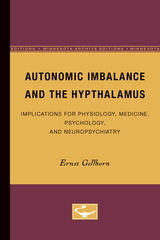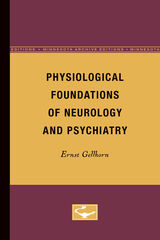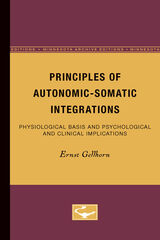3 books about Gellhorn, Ernst

Autonomic Imbalance and the Hypthalamus
Implications for Physiology, Medicine, Psychology, and Neuropsychiatry
Ernst Gellhorn
University of Minnesota Press, 1957
Autonomic Imbalance and the Hypothalamus was first published in 1957.Fundamental alterations in the reactivity of autonomically innervated structures frequently have been observed in physiological tests as well as under clinical conditions. However, the mechanism of these alterations and the changes in the reactivity of the central structures of the autonomic nervous system that are their most frequent site of action had not been subjected to systematic, experimental analysis until Dr. Gellhorn launched the investigations he reports in this volume.The influence of the sino-aortic reflexes on the hypothalamus and the cortex is analyzed experimentally, and new data on the relation of the hypothalamus to vascular, respiratory, and visceral functions are presented. On the basis of his physiological work Dr. Gellhorn shows how clinically applicable methods for the diagnosis of parasympathetic and sympathetic disorders at the hypothalamic level may be devised. He shows the significance of his observations for an understanding of the physiology of the emotions and suggests clinical applications to such problems as hypertension, central autonomic disorders, and functional psychoses. The influence of age on parasympathetic and sympathetic excitability is shown on control subjects and on neuropsychiatric patients, and significant differences between these two groups at similar age levels are disclosed.For the convenience of the clinical reader the experimental results are summarized in a special section before the clinical applications are discussed.
[more]

Physiological Foundations of Neurology and Psychiatry
Ernst Gellhorn
University of Minnesota Press, 1953
Physiological Foundations of Neurology and Psychiatry was first published in 1953.The findings of Dr. Gellhorn’s extensive and significant research on the physiology of the central nervous system form the basis of the discussion in this volume. Reference is frequently made to the applicability of this laboratory experience to clinical as well as other fields. An attempt has been made to integrate the clinical and experimental literature with the discussion, to give an up-to-date picture of the problems involved and to indicate the possibilities for future investigation. Topics of interest to physiologists, endocrinologists, internists, neurologists and neurosurgeons, psychiatrists, and clinical psychologists are discussed.An important aspect of the author’s work concerned certain recent tests which show an altered reactivity of autonomic centers in the psychotic condition. His interpretation of the significance of these tests for a physiologically oriented therapy of functional psychoses is published here for the first time. The physiological effects actually produced in the central nervous system by “shock” treatment and carbon dioxide therapy are analyzed.Other sections give consideration to some of the principal working mechanisms of the neuron, to the factors determining movements and convulsions, to the pathophysiology of cortical lesions, to some aspects of autonomic physiology, and to the problem of consciousness. An important section deals with integrative functions of the nervous system - those involved in emotion, the conditioning process as the basis of behavior, and homeostasis.
[more]

Principles of Autonomic-Somatic Integrations
Physiological Basis and Psychological and Clinical Implications
Ernst Gellhorn
University of Minnesota Press, 1967
Principles of Autonomic-Somatic Integrations was first published in 1967.For a number of years Dr. Gellhorn, a professor emeritus of neurophysiology at the University of Minnesota, conducted research on various problems stemming from the need for a better understanding of the autonomic nervous system. In this book he continues his contributions on the subject, providing a significant analysis of the relationship between the autonomic and somatic systems and the implications for medicine and psychology of the principles established. The book is based on an extensive review of the international literature, of which more than 1,000 references are cited.Dr. Gellhorn points out that research in the last two decades has shown that hypothalamic and reticular mechanisms play a fundamental role in the regulation of somatic sensory and motor functions as well as visceral functions. The role of such mechanisms in functions that represent fragments of behavior has been studied in great detail, and the importance of the mechanisms in the integration of diverse systems has been emphasized. He now suggests that a few basic principles are involved in the integration of a complex maze of organs and processes and that this integration results in a coherent pattern of total behavior. In the light of these principles he provides a broad physiological interpretation of behavior and explores various clinical implications.The book will be of particular interest to physiologists, neurologists, psychiatrists, and psychologists.
[more]
READERS
Browse our collection.
PUBLISHERS
See BiblioVault's publisher services.
STUDENT SERVICES
Files for college accessibility offices.
UChicago Accessibility Resources
home | accessibility | search | about | contact us
BiblioVault ® 2001 - 2024
The University of Chicago Press









